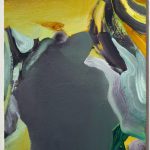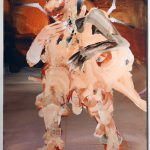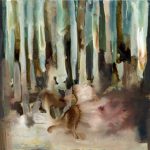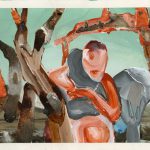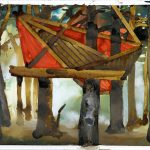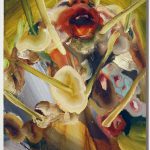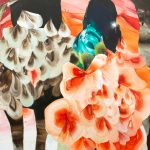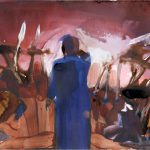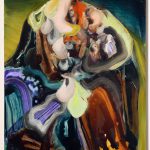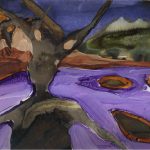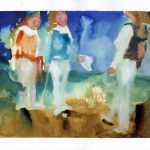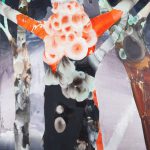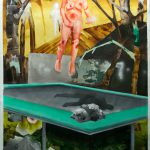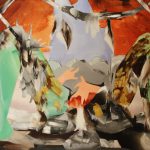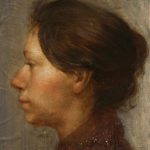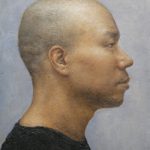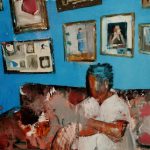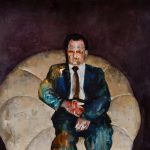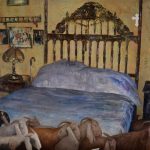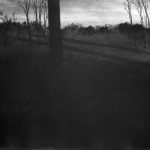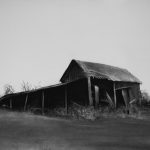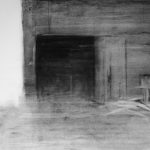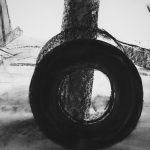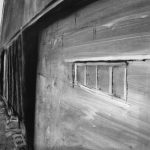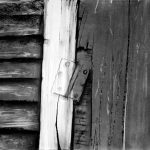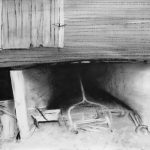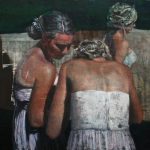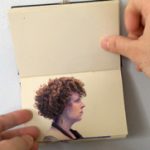Take Home a Nude, and an Interview with Gabriela Palmieri
 |
| Black Bottoms, by Tim Noble and Sue Webster |
This year’s 23rd annual Take Home a Nude took place on October 9th at Sotheby’s. Although today’s Academy students still spend a minimum of twelve hours a week drawing from the nude figure during their first year, the work showcased at Take Home a Nude this year included a wide range of subjects, from abstracted elephants and minotaurs to chandeliers and seashells. Of the 184 lots featured, (including work by Will Cotton, Alex Kanevsky, Vincent Desidirio, and Laurie Simmons, to name only a few) there were around 50 nudes – and the definition of what constitutes a “nude” is a loose one. Some of my favorite pieces were butt cheek prints by Tim Noble and Sue Webster, “Black Bottoms.”
 |
| Gabriela working the crowd |
Before the night kicked off, I interviewed Ms. Palmieri about her involvement with the Academy, Take Home a Nude, her work at Sotheby’s and her love of art in general. Here is our conversation.
 |
| Gabriela in front of a Hot Lot piece |
Artist-in-Residence Program at China 2014
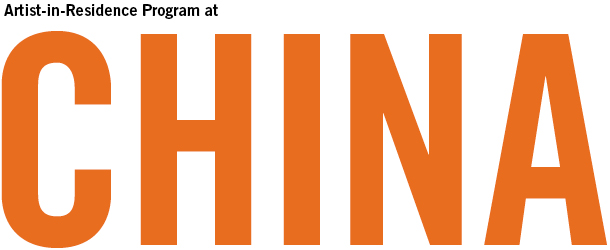
During the summer of 2014 Tamalin Baumgarten (MFA 2015), Dana Kotler (MFA 2015), Arcmanoro Niles (MFA 2015), and Ryan Schroeder (MFA 2015) participated in a six-week Artist-in-Residence Program on the University of Shanghai campus. At the end of the residency all four artists participated in the group exhibition Mutual Interests 3 Cross Culture Exhibition at the Fine Arts Gallery at University of Shanghai. This exhibition includes some of the work created during or attributed to their residency experience.
The Academy’s China Residency is made possible by the New York Academy Travel Fund, the Villore Foundation and Academy Trustee Gordon Bethune.
- Tamalin Baumgarten (MFA 2015)
- Tamalin Baumgarten (MFA 2015)
- Tamalin Baumgarten (MFA 2015)
- Dana Kotler (MFA 2015)
- Dana Kotler (MFA 2015)
- Arcmanoro Niles (MFA 2015)
- Ryan Schroeder (MFA 2015)
- Ryan Schroeder (MFA 2015)
Babies on Top of Cabinets, Surrealist Mollusks, and a Life Sized Mermaid
“It’s hard to say life is small, delicate, and vulnerable unless you can show the real size of life,” says New York Academy of Art’s newest Senior Critic Judy Fox. On September 17th, Fox discussed the presence of abstraction in sculpture with renowned abstract sculptor and Pace artist Joel Shapiro for the Academy’s first Art and Culture lecture of the school year. While Shapiro spoke about arriving at meaning through the process of sculpting, Fox explained her highly premeditated way of working. “The emotional effect is one of unattained glory, of someone trying to be something they’re not – a regular person trying to play a grand role,” says Fox, who relies on iconic figures from art or history, as well as a model she’s forced into the iconic pose and photographed. As she works, she observes the inherent tension between the real and the ideal.
The day after the lecture, I went to Fox’s studio to interview her about her work. I removed my shoes at the door, and almost immediately had a layer of silky sculpture dust covering my bare feet. Natural light poured in from a wall of windows, and NPR – which Fox listens to constantly as she works – blasted from the radio. Strange figures stared me down from all over the room – babies on top of cabinets, surrealist mollusks, and a life sized mermaid from her 2012 PPOW show, “Out of Water.” Fox sat sculpting and continued to sculpt for the duration of our conversation.
CC: What are you working on now?
JF: I like to look at mythology, including religion, and think about the psychological and sociological themes that the myths are addressing. I reanalyze myths in a frank, contemporary, science-oriented way. I pillage all of time and civilization, and choose myths wherein the imagery seems to suggest a new interpretation by contemporary standards.
CC: Can you tell me how you arrived at your mollusk sculptures?
JF: I was thinking about evolution as an approach to visualizing the Garden of Eden. So I was reading the bible and I was side tracked by the third day, when the seas were created. I started thinking about primordial muck, primitive life forms, and sea monsters. I was interested in our connection to PRIMATIVE life, and our fear it, fear of monsters… you can see sea monsters at the side of old maps back when people believed the world was flat. These snakey, reptile wormy monsters were the inspiration for the worms. They were fun to make. You have to have a good time.
CC: What source images were you using to create these?
JF: I just worked from magazine and internet pictures, whatever I could get. Cephalopods are very flexible in the flesh, but they do have some anatomy, which I tried to study. I worked out the anatomy but also hybridized them with certain ideas I had, to give them different characters. I was using my ability to invoke human expression, to make them look like a person of one type or another. We are all animals, so we have certain things in common with them. We are fairly related even though not… I wanted to emphasize this ability to empathize across species. I was using form as a way of evoking aspects of human experience in a humorous way. CC: What are you currently reading?
JF: I try to have a novel going… right now I am reading “Benang,” a novel by an Australian aboriginal writer, Kim Scott. I love anthropology of all kinds. That comes with being a figurative artist – you like to learn about the human experience from all sides. I tend to read science magazines and collect information that way. And listen to NPR.
CC: What artists are you looking at historically?
JF: My main stylistic influences/brothers are Northern Renaissance sculptors. I also love High Gothic sculpture, which is much more attentive to individual character. It’s actually kind of easy to make a Renaissance sculpture because all you really need is anatomy and curvilinear resolution. But to actually get all the individual character into it you have to observe a real example of a person. CC: You mentioned during the lecture that you found observing nature more interesting than working from your imagination.
JF: When I was a student, I was once trying to finish up a piece and thought – “I’ll just make up the belly button,” which came out fine. Then the model came in, and damned if her bellybutton wasn’t way more interesting than the one I made! I realized that the act of understanding something is the act of trimming away all the irregularities. So I decided I was going to fight against that and stick to nature. For example, in painting, once you get some idea of what light and shadow looks like, you can probably do it credibly. But you’re never going to be Vermeer that way. There’s just nothing like actually observing real light and the myriad of color reflections. I encourage any artist to work from life. There’s no substitute for going out there and looking at reality.CC: You spoke about trying to create tension between a model’s personality and the role you are trying to fit them into.
JF: In some cases, the model’s personality meshes with the hero or the figure they’re playing – that can work sculpturally, like in Shiva dancing. The model was a very confident, tough little kid – his personality fit very well with the Hindu god shiva, the creator and destroyer. So that worked well for the piece even though it wasn’t a very “tense” outcome. When the models are really different from the role I’m trying to place them into it creates tension, and makes a more poignant outcome. The sculpture becomes more about trying something that’s difficult. Both things are truth. It works in either direction. That said, there are still some pieces that end up more captivating than other pieces in the end.
CC: Do you ever scrap pieces, if you’re not happy with them?
JF: Of course I try to only make pieces that are going to be good because they take me so long to make, but some of them really end up being stronger than others. And since I’ve spent months and months on them, I use those pieces too. I show them all. It’s a big ceramicist thing to throw away imperfect pieces of your work. But ceramicists don’t usually work on a piece for a year. CC: What is your pace?
JF: About one month for every ten inches of sculpture. Sculpting an adult takes me about nine months. And then by the time it’s fired, put together, seams fixed, it’s effectively a year for a life-sized adult. Kids are faster. And surrealist things are faster because they’re straight out of my head. CC: As an undergraduate in the 1970s, you made abstract constructions. How did you move from these works to the strictly figurative work you are making now?
JF: I loved doing the constructions and probably would have continued making them had I been accepted into the Whitney Independent study program – they would’ve discouraged figure – but then I wasn’t accepted, so I went to art conservation school at NYU. This was cool because no art school at the time would have encouraged me in any way to do the figure. But taking art history courses exposed me to very serious interpretations of figuration and its various styles. I was also doing my own work and working out a way of doing the figure that reflected my own time.
CC: What skills did you learn at NYU that you use in your work now?
JF: That program was where I was really introduced to polychrome sculpture, because most sculpture in the ancient world was painted. It was really more of a post 19th century thing to have everything be colorless. Art conservation taught me to mix and layer colors, as part of replacing lost areas. Kind of by surprise, it was a great place to learn to make art, and a fun education.
CC: What kind of work did you do as a conservator?
JF: When I finished graduate school in 1984, I started my first job at NYAA. I was taking care of their cast collection, which had a tendency to get broken by party revelers – I would glue them back together, fill the losses, the usual restoration routine. I later joined a private business that worked on Modern and Contemporary Art. Being a conservator saved me from having to do the usual kind of hustling that artists so often have to do. It was a great day job, and overlapped with my studio needs. CC: Were you ever interested in working 2D?
JF: I’m just a natural sculptor, and am very literal minded. It’s possible for me to draw, but I wouldn’t credit myself with having developed a drawing language that works. I have respect for drawing and painting, but I don’t really like doing either. For example, I painted my Cuttlefish sculpture with a colorful pattern on its back, and it was tedious for me to paint within the lines. I don’t love it, but I have to paint to give my sculptures that sense of life.
CC: When and how did you come to a clear idea of what you were trying to say with your work?
JF: I didn’t come to a clear sense of how to make figures contemporary for a long time. I was searching for a way to express certain things for years. For example, I wanted to avoid monumentality in favor of subtlety and intimacy. I went down a few dead ends, but when I started the baby series in 85, I knew that the sculptures were finally taking care of all the things I wanted to say. Eventually the language of form that I developed became my style. In the 70s, the grad students would say “Why would you make a figure, why bother?” When I started to do the baby series it was like “well, it’s a figure because my work is about human issues and personality.” Modernism had gone so far as to chop off heads and do just torsos, and abstract elements of the body. The head, and the mind in it, was important subject matter to me. I was looking to make figures that addressed contemporary life in an interesting way.
Judy Fox contributed two essays in The Figure: Painting, Drawing, and Sculpture – Contemporary Perspectives, the New York Academy of Art’s debut monograph
celebrating the art of the human figure, published by SkiraRizzoli .Her conversation with Joel Shapiro is featured on the Academy’s Vimeo page and her extraordinary work can be seen on her website www.judyfox.net
Chasing Light – Painting and Teaching Within the Magical Landscape of Altos de Chavon
 By Lily Olive (MFA 2015)
By Lily Olive (MFA 2015)
I spent this past August immersed in the magical environment of Altos de Chavon as one of the recipients of the New York Academy of Art Altos de Chavon Artist and Teaching Residency, living and breathing what seemed to be some kind of mirage of an idealized ultimate painter’s paradise. I along with three other NYAA alumni: Ivy Hickam (MFA 2013), Ian Factor (MFA 2014) and Alfonso Gosalbez Berenger (MFA 2014), were given the fortunate opportunity to be selected to teach and work at La Escuela de Diseño Altos de Chavón, a design school in La Romana, Dominican Republic this Summer as part of an ongoing dialogue and exchange program NYAA and Altos de Chavon established last year. Chavon is an affiliate of Parson ́s School of Design in New York.
Ian and Ivy went down in June for the first residency round, and Alfonso and I followed in August for the second round. Ian instructed a class on anatomical drawing, Ivy gave a class on introduction to printmaking, Alfonso taught a landscape painting class, and I taught a class on art historical modalities and contemporary art, a brief survey of a variety of historical technical processes and painting exercises, lectures and several conceptual drawing exercises.
We all overlapped our time there by one week in the beginning of August. Ian and Ivy, along with the wonderful teachers and staff of Altos, helped welcome Alfonso and I to the school and showed us the lay of the land. It was very special to be able to spend that time together with each other painting outside, printmaking with Ivy and the students, taste testing delicious Dominican foods liketostones (fried green plantains!), and working on my Spanish language survival skills.
One night, we even ate fried parrot fish at Bayahibe, a beautiful nearby local beach, inside a gift shop surrounded by dresses, wind chimes, painted shells, and palm tee paintings, as torrential rain surprised us and had interrupted our dominos game and dinner on folding tables in the sand..the scramble to retreat inside away from the sheets of gusty rain, grabbing plates of steaming hot fish and cold Presidente beers wrapped in soggy napkins as we ending up moving our dinner from beach to open air gift shop was an experience I will not forget anytime soon.
I kept telling the other residents and teachers at the school that the stunning natural beauty was so overwhelmingly gorgeous, it was borderline saccharine. Certainly a nearly impossible feat to try to capture moments of fading suffused sunsets, jeweled sunbeams dancing and diving across frothy turquoise crests, mangos and coconuts weighing down above, hanging heavy amongst the medieval style architecture.
Bright yellow plums dotted the pathways, butterflies darted in and out of huge yellow, radiant magenta, pink and white tropical blossoms, and light flickered in and out of swaying palm trees. Geckos and iguanas roamed in and out of our housing, and stray kittens mewed at us for scraps. “Cheese” the cat, a beautiful
mottled gray and white gregarious feline with emerald eyes befriended me quickly, and he spent days following me around, jumping into my lap and demanding attention and treats.
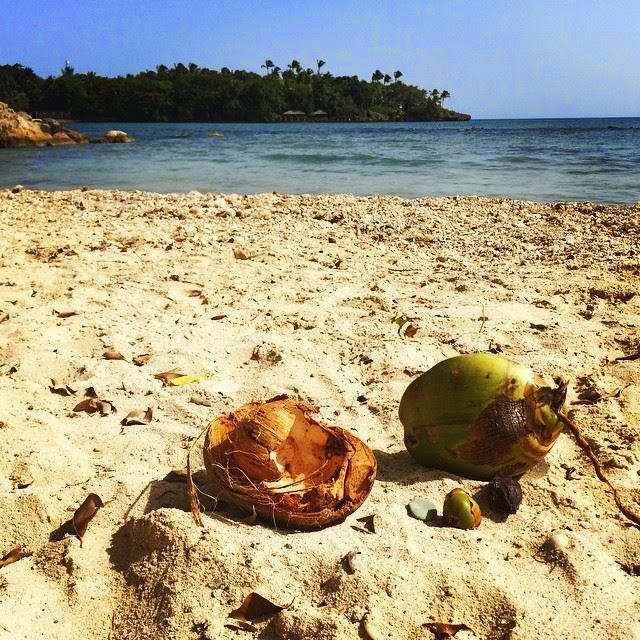 It was paradise realized as far as I was concerned. Perhaps we had landed in an episode of Lost or were living like Tom Hanks character in Castaway I mused, as I scrambled up trees to grab mangos and coconuts, victoriously smashing them open. Life existed everywhere I looked, cacti sprouting out of red rocks, orangey red flowers from the Flamboyant trees lining the roads, pathways, swimming pool, and lighting up the environment with their fiery chroma.
It was paradise realized as far as I was concerned. Perhaps we had landed in an episode of Lost or were living like Tom Hanks character in Castaway I mused, as I scrambled up trees to grab mangos and coconuts, victoriously smashing them open. Life existed everywhere I looked, cacti sprouting out of red rocks, orangey red flowers from the Flamboyant trees lining the roads, pathways, swimming pool, and lighting up the environment with their fiery chroma.
A brief background on Altos. Recreated as a 16 community, perched upon a cliff above the Chavon River. Construction of the village began in 1976 and the village was inaugurated in 1982 with the concert by NYC’s one and only Frank Sinatra at the amphitheater. The village was designed by Dominican architect Jose Antonio Caro, and created by Italian master designer and cinematographer Roberto Coppa.The village, in addition to being home to the Altos de Chavon School of Design, also house shops, boutiques, fine art galleries, restaurants and an archaeological museum atop the picturesque cliffs. The residency consisted of having art studios in a great thatched hut to work out of, and one week of leading and teaching a painting workshop; mine was called History of Painting Techniques and Contemporary Art. The schools administration and staff were beyond welcoming, Carmen Lorente, the schools academic director, helped us realize and make possible the lessons and ideas we had for our classes and material lists. It was fantastic!
The schools administration and staff were beyond welcoming, Carmen Lorente, the schools academic director, helped us realize and make possible the lessons and ideas we had for our classes and material lists. It was fantastic!
We had lunches together almost daily, and debriefed each other on how our students were progressing, what ideas we had planned for our class lessons, and often lobbying for trips to the beach to plein air.
As a teacher, the experience of having such hardworking and dedicated students was extremely rewarding, and it was a pleasure to push them and see the results. A week is unfortunately not nearly enough time to impart as much knowledge as one would like, but it is long enough to experience very intense immersions into a variety of techniques and experiences together as a class. I gave lectures, painting demos, assisted during lessons, and encouraged the students to keep pushing through the lessons, which were very challenging for them, but they stood up to the demands and dove into their work, with impressive results. It was not uncommon to spend quite a bit of time after class, sometimes hours, assisting the students in continuing to work through their paintings and assignments for that days class. I was touched with how much genuine dedication and love they had for their crafts.
After the classed ended, I spent the rest of my trip outside, plein air painting from life. The time escaped quickly, and I spent entire days working frantically to try to put down color and light and capture as much of the environment as I could.
The landscape, the students, the staff and the entire experience was beautiful and rewarding. We are all so grateful to have been given these opportunities, and I am looking for ways to go back and visit my new Dominican friends as soon as possible.
Mucho Gracias!
Lily
###
Ivy Hickam (MFA 2013), Ian Factor (MFA 2014) and Alfonso Gosalbez Berenger (MFA 2014) and Lily Olive (MFA 2013) spent their summer on an Academy sponsored teaching residency in Dominican Republic.
ELIZABETH GLAESSNER’S QUIET CONFIDENCE
 Have you had the chance to see the “2014 Fellows Show” at the Academy? If not, RUN don’t walk to Wilkinson Gallery, 111 Franklin Street, before it closes on Sunday, September 29th. At the show you will be drawn to Elizabeth Glaessner’s (MFA 2013, Fellow 2014) work. Her post-apocalyptic paintings slowly reveal intricate allegories suspended in time. Her chromatically vivid, psychologically dense, personal narratives take the viewer on a journey through the artist’s interior life. Both intensely strategic and wildly intuitive, each detail of her work has a jewel-like quality that is the result of the artist’s extreme focus. And yet, when taken as a whole, the improvisational nature of the work links every component into a rapturous symphony of exotic symbols and voluptuous color.
Have you had the chance to see the “2014 Fellows Show” at the Academy? If not, RUN don’t walk to Wilkinson Gallery, 111 Franklin Street, before it closes on Sunday, September 29th. At the show you will be drawn to Elizabeth Glaessner’s (MFA 2013, Fellow 2014) work. Her post-apocalyptic paintings slowly reveal intricate allegories suspended in time. Her chromatically vivid, psychologically dense, personal narratives take the viewer on a journey through the artist’s interior life. Both intensely strategic and wildly intuitive, each detail of her work has a jewel-like quality that is the result of the artist’s extreme focus. And yet, when taken as a whole, the improvisational nature of the work links every component into a rapturous symphony of exotic symbols and voluptuous color.
Q: What are the major themes you pursue in your work?
A: Ritual, absurdity, meaning, invented mythology, shifting landscape, horror
Q: Where did you grow up?
A: Things I see everyday – often the most banal objects seem to have the most potential to be transformed into something totally ecstatic.
Q: If you could retake any class at the academy what would it be and why?
A: All of the master classes I took – Julie Heffernan, Natalie Frank, Inka Essenhigh – those were all incredibly influential and encouraging for me. Also, Wade’s animal class (but with a mask to eliminate the smell), Jacobsmeyer’s comp and design, Catherine Howe’s alchemical painting, Margaret Bowland, Monica Cook, any class where Kurt Kauper lectures.
Q: What materials do you like to use and how do you know when your work is finished
 Q: During your post-graduate year, what did you learn most about yourself and practice?
Q: During your post-graduate year, what did you learn most about yourself and practice?A: I learned to trust my instincts more and the importance of community and conversation.
A: Be idealistic and read the news.
Q: What 3 quirky things can we find in your studio?
A: My stuffed chipmunk, Chester, plaster chicken feet and a studio mate.
Q: Do you paint to music or paint in silence?
A: both, today I was listening to Nancy Sinatra and La Luz but I switch it up often.
A: A little more bitter.
A: “Those that Prefer to Stay in Trees” This 4 by 6 foot work on panel depicts a creature half born out of a tree bearing mutations which are indicative of what we might call a toxic environment, however in this world these mutations are celebrated and the toxic landscape becomes a place where new creatures and mutants thrive. This particular creature is enamored with the Lady of Ephesus (the Ionian fertility goddess) adapting her accessory breasts and presenting herself as a source of nourishment and birth. She has a commanding presence and watches outward with an ominous eye.
Q: Finally, what’s next? Any immediate plans to share?
A: I’ll be working in my studio in Greenpoint, continuing to work with all the incredible people at P.P.O.W. and teaching once a week at Montclair University. I also look forward being a part of another critical and inspiring community!
Annually, the Academy awards Post-graduate fellowships to three exemplary graduating students chosen through a highly competitive selection process. During their Fellowship year, the Fellows receive studio accommodations, a stipend, exhibition opportunities and teaching assistantships to expand the depth and breadth of their artistic practice. The “2014 Fellows” show represents the culmination of their Fellowship year and entree into the art world as professional artists.
Yunsung Jang’s Universal Spirit
 |
| ‘Mother # 1’, 2013, oil on canvas |
Q: What were you trying to convey in your painting?
A: My painting is bigger than my relationship with my mom. ‘Mother #1’ is about the universal relationship and love between mother and child. I wanted my feelings to transfer to the viewers to be able to connect them with their own childhood memories and love for their parents (if that’s even possible).
A: Humanism, nature and anyone who dedicated to humanity.
 |
| Detail, ‘Aki,’ 2014, oil on canvas |
A: I always try to eat an apple before I start to work so I wont get hungry and have to stop in the middle of something. I set up working and put headphones on with some classical music or Disney music and start to work. I always clean up and put everything back in its place.
Q: How has the Academy shaped your practice?
###
2014 New York Academy of Art Fellows
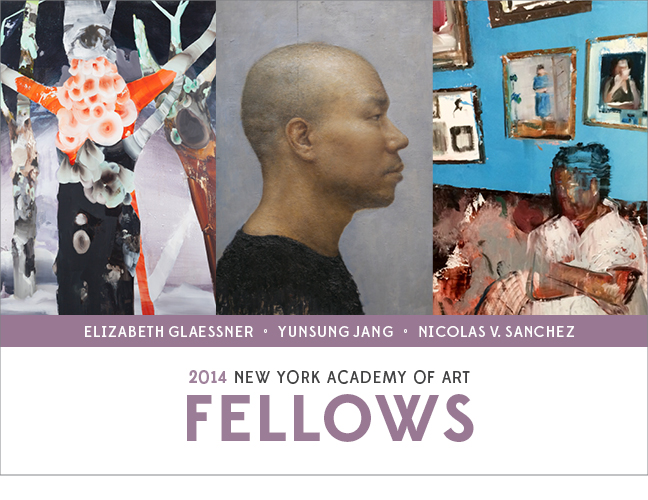
Featuring work by painters Elizabeth Glaessner, Yunsung Jang and Nicolas V. Sanchez, this exhibition marks the beginning of each artist’s promising career and the culmination of their year-long fellowships. Each year, the Academy selects three outstanding graduates of its MFA program as Chubb Fellows. The fellowship, sponsored by Chubb, is the highest honor the Academy bestows, and is given to the three graduates who exemplify the Academy’s mission of valorizing technical skill in the service of creating vital contemporary art.
For inquiries please contact Elizabeth Hobson: 212.842.5966 / exhibitions@nyaa.edu
- Elizabeth Glaessner (MFA 2013, Fellow 2014)
- Elizabeth Glaessner (MFA 2013, Fellow 2014)
- Elizabeth Glaessner (MFA 2013, Fellow 2014)
- Elizabeth Glaessner (MFA 2013, Fellow 2014)
- Elizabeth Glaessner (MFA 2013, Fellow 2014)
- Elizabeth Glaessner (MFA 2013, Fellow 2014)
- Elizabeth Glaessner (MFA 2013, Fellow 2014)
- Elizabeth Glaessner (MFA 2013, Fellow 2014)
- Elizabeth Glaessner (MFA 2013, Fellow 2014)
- Elizabeth Glaessner (MFA 2013, Fellow 2014)
- Elizabeth Glaessner (MFA 2013, Fellow 2014)
- Elizabeth Glaessner (MFA 2013, Fellow 2014)
- Elizabeth Glaessner (MFA 2013, Fellow 2014)
- Elizabeth Glaessner (MFA 2013, Fellow 2014)
- Elizabeth Glaessner (MFA 2013, Fellow 2014)
- Elizabeth Glaessner (MFA 2013, Fellow 2014)
- Elizabeth Glaessner (MFA 2013, Fellow 2014)
- Elizabeth Glaessner (MFA 2013, Fellow 2014)
- Yunsun Jang (MFA 2013, Fellow 2014)
- Yunsun Jang (MFA 2013, Fellow 2014)
- Yunsun Jang (MFA 2013, Fellow 2014)
- Nicolas V. Sanchez (MFA 2013, Fellow 2014)
- Nicolas V. Sanchez (MFA 2013, Fellow 2014)
- Nicolas V. Sanchez (MFA 2013, Fellow 2014)
- Nicolas V. Sanchez (MFA 2013, Fellow 2014)
- Nicolas V. Sanchez (MFA 2013, Fellow 2014)
- Nicolas V. Sanchez (MFA 2013, Fellow 2014)
- Nicolas V. Sanchez (MFA 2013, Fellow 2014)
- Nicolas V. Sanchez (MFA 2013, Fellow 2014)
- Nicolas V. Sanchez (MFA 2013, Fellow 2014)
- Nicolas V. Sanchez (MFA 2013, Fellow 2014)
- Nicolas V. Sanchez (MFA 2013, Fellow 2014)
- Nicolas V. Sanchez (MFA 2013, Fellow 2014)
- Nicolas V. Sanchez (MFA 2013, Fellow 2014)
- Nicolas V. Sanchez (MFA 2013, Fellow 2014)
- Nicolas V. Sanchez (MFA 2013, Fellow 2014)
An Unforgotten Past: The Work of Nicolas V. Sanchez
A: Wade’s drawing class
A: I learned more about what drawing and painting mean to me.
A: The only thing I do consistently in the studio is clean up before I leave. I need a clean and somewhat organized space so I can focus when I return. I love being able to arrive at my studio and within minutes begin working.
Currently, Nicolas V. Sanchez’s work is featured in the “2014 Fellows” exhibition on view at the Academy’s Wilkinson Gallery through September 28th. This three-person show also features the work of 2014 Fellows Elizabeth Glaessner and Yunsung Jang.
To see more work from Nicolas V. Sanchez please visit his website. Stay tuned for more interviews from Elizabeth Glaessner and Yunsung Jang during the exhibition’s three week run.
One of the Best Paintings I Have Ever Seen
I know that I speak for everyone on the Moscow residency when I say that our time here has been, and continues to be, spectacular. Apart from the every day luxuries of our imperial style Stalin-era skyscraper apartment and access to a beautiful and historically significant painting studio, one of my favorite things about Russia has been visiting the museums. We have visited nine museums: The Tretyakov Museum, The Tretyakov’s Modern Art Museum, the Master and Margarita Museum, The Moscow Museum of Modern art (MMOMA), The Baron Steiglitz Academy and Museum, The Academy of Art’s Museum, The Hermitage, the Russian Museum, and the Pushkin Museum. The Tretyakov Museum has become a very familiar place to us during our Monday copying days. The museum is closed to the public on that day and we are allowed six hours to paint, draw, and wander around the museum. They have a great collection of Repins, and also some remarkable Vasily Vereschagins, one of which James is copying.
The Tretyakov Museum has become a very familiar place to us during our Monday copying days. The museum is closed to the public on that day and we are allowed six hours to paint, draw, and wander around the museum. They have a great collection of Repins, and also some remarkable Vasily Vereschagins, one of which James is copying.
Fortunately, our translator Sonia arranged for us to have a private (English) tour of the Tretyakov’s Modern Art Museum, where we learned about artists like Goncharova, Pavel Filonov, Alexander Yakovlev, and of course, Kandinsky.
The Master and Margarita Museum was a special treat for me, because last semester (coincidentally before I knew I was going to Moscow,) I read Mikhail Bulgakov’s masterpiece, The Master and Margarita; a book that caused a lot of controversy at the time of it’s release in 1940, but is now completely embraced and championed by the people of Moscow. The museum is located in the actual apartment where the main characters in the book lived. Outside of the museum, our translator lets me know when we pass other locations referred to in the book, and I am very excited to see them.
We visited the Moscow Museum of Modern art as part of the biennale tour. The biennale lead us to several galleries and finally the MMOMA to see works of contemporary art by young artists. Most of the work was either instillations (video and other) or photography. Unfortunately very few paintings were included in the shows (if I remember correctly there were two small, non-representational paintings).In St. Petersburg, we met a student who attends The Baron Steiglitz Academy. He brought us into the school and showed us around. The Baron Steiglitz Academy and Museum is one of the most extraordinary places I have ever had the privilege of touring. The site of this famous academy is one of the former homes of Baron Steiglitz, a nineteenth century philanthropist. Any description I can give will fail to do the building justice (think NYAA meets Versailles.) Students are surrounded by so much visual language provided by the building itself that in some rooms, large movable walls cover up the ornate wooden carvings, or other decorative features adorning the walls. We all agreed that The New York Academy of Art should begin a relationship with The Baron Steiglitz Academy.
The Academy of Arts Museum had a few rooms of thesis paintings by their more noteworthy alumni, as well as several rooms displaying architectural prototypes used to plan the design and construction of famous buildings in St. Petersburg. Nikita, the same student who showed us around the Baron Steiglitz Academy, convinced the Academy of Arts Museum to allow us access to their school building, which was “closed for the summer, but also the fire.” The building was massive and abandoned. We were never given the details explaining the circumstance of the fire, but it was very obvious that this school had somewhat recently suffered a devastating fire, and was now scarred from it.
Then, of course, there was the Hermitage. The Hermitage is home to one of the greatest collections of art in the world. We spent two full days in the Hermitage and saw works by Rembrandt, Degas, Cezanne, Bonnard, Brueghel, Rubens, Titian, Pontormo, El Greco, Velazquez, Gentileschi, Goya, Ribera, Gerome, Bouguereau, Michelangelo, and many others. I am eternally grateful to the New York Academy of Art for giving me the opportunity to visit this museum.
We visited the Russian Museum on our last day in St. Petersburg and saw a remarkable collection including works by Filonov, Kramskoy, and, of course, Repin. The Russian Museum has an unrivaled collection of Repin paintings, including Zaporozhye Cossack’s Writing a Mocking Letter to the Turkish Sultan, one of the best paintings I have ever seen.
Amanda Pulham (MFA 2014) is joined by Gabriel Zea (MFA 2015), Sarah Issakharian (MFA 2015), and James Raczkowski (MFA 2015) in Moscow. These four students are spending their summer taking in the sights and creating work on an Academy-sponsored Artist in Residence Program. Throughout the summer, their adventures will be documented on the Academy’s blog. Stay tuned for more.




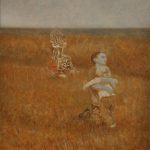
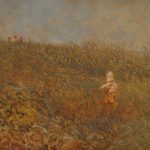
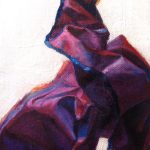
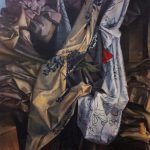
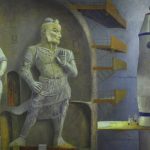
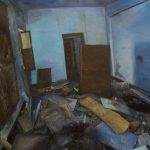
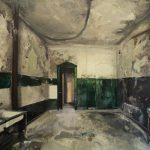




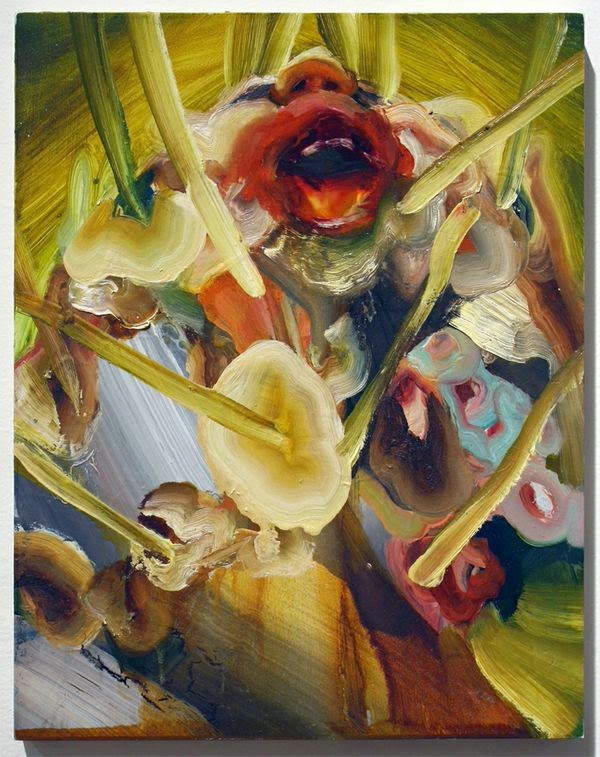

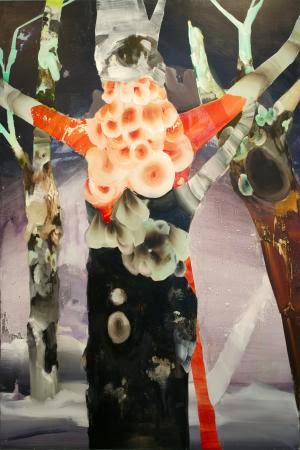



.jpg)
%2Bfor%2Bshow.jpg)


